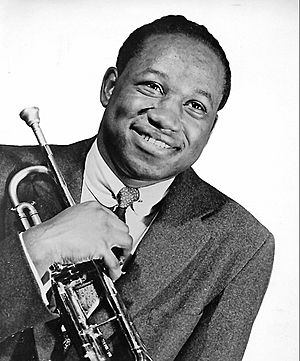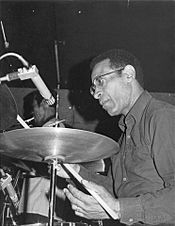Clifford Brown facts for kids
Quick facts for kids
Clifford Brown
|
|
|---|---|

Brown c. 1956
|
|
| Background information | |
| Birth name | Clifford Benjamin Brown |
| Born | October 30, 1930 Wilmington, Delaware, U.S. |
| Died | June 26, 1956 (aged 25) Bedford, Pennsylvania, U.S. |
| Genres | Jazz |
| Occupation(s) | Musician, composer |
| Instruments | Trumpet |
| Years active | 1949–1956 |
| Associated acts | Max Roach, Harold Land, Lionel Hampton, Sonny Rollins |
Clifford Benjamin Brown (born October 30, 1930 – died June 26, 1956) was an amazing American jazz trumpeter and composer. He sadly passed away at just 25 years old in a car accident. Even though his career was short, he left behind four years of incredible music. Some of his songs, like "Sandu," "Joy Spring," and "Daahoud," are now famous jazz tunes that many musicians play. Clifford Brown was recognized as a rising star in 1954 by DownBeat magazine, a popular jazz publication. Later, in 1972, he was added to the DownBeat Hall of Fame, which is a special honor for jazz legends.
Contents
Becoming a Jazz Trumpeter
Early Musical Journey
Clifford Brown grew up in Wilmington, Delaware, in a family that loved music. His father even formed a singing group with Clifford and his three brothers! When he was about ten, Clifford started playing the trumpet at school. He was really drawn to the shiny trumpet his dad owned. By age thirteen, his father bought him his own trumpet and arranged for him to have private lessons. In high school, Clifford learned from a teacher named Robert Boysie Lowery and played in a jazz group that traveled to Philadelphia.
College and Early Influences
Clifford first studied math at Delaware State University, but he later moved to Maryland State College. After high school, he visited Philadelphia more often to play music. He also played in the fourteen-piece Maryland State Band, which focused on jazz. In June 1950, he was in a car accident after a show. While he was recovering, the famous jazz trumpeter Dizzy Gillespie visited him and encouraged him to keep playing music. For a while, his injuries meant he could only play the piano.
Clifford Brown was greatly inspired by another trumpeter named Fats Navarro. His first recordings were with an R&B bandleader named Chris Powell. He also worked with other jazz greats like Art Blakey, Tadd Dameron, Lionel Hampton, and J. J. Johnson. Later, he formed his own band with Max Roach.
Forming the Jazz Messengers
A big moment for Clifford Brown was when he helped form Art Blakey's Quintet, which later became known as the Jazz Messengers. This group included Brown, Lou Donaldson, Horace Silver, and Curley Russell. They recorded their first album live at the famous Birdland jazz club. During one practice, Miles Davis, another well-known trumpeter, listened and was amazed by Clifford Brown's skill!
In May 1952, Clifford Brown played with the legendary alto saxophonist Charlie Parker at Club Harlem. Brown later said that Parker was so impressed with his playing that he told him privately, "I don't believe it." Just before he formed his famous group with Max Roach, a journalist wrote an article about Clifford Brown called "Clifford Brown – the New Dizzy," showing how much people admired his talent.
Leading a Famous Jazz Quintet
The Clifford Brown/Max Roach Quintet
Max Roach was a very respected drummer who had played with many rising stars. He invited Clifford Brown to Los Angeles in 1954. Together, they formed the amazing Clifford Brown/Max Roach Quintet. This group included tenor saxophonist Harold Land, pianist Richie Powell, and bassist George Morrow. Later, Sonny Rollins joined as the saxophonist in 1955.
The band started by renting a studio in California. Clifford Brown could also play piano and drums, so he and Max Roach experimented a lot with different instruments. They decided on a classic jazz setup: trumpet, saxophone, piano, bass, and drums. They chose their first members, though the lineup changed a bit. This new group "sent shock waves throughout the jazz community" because they were so good!
Recording and Touring
While the band was still deciding on its members, Brown and Roach met Eric Dolphy, a talented saxophone player who hosted jam sessions at his apartment. Future band members Harold Land and George Morrow often played there. Richie Powell, the brother of jazz pianist Bud Powell, also joined as the quintet's pianist. The band started recording albums, and Clifford Brown wrote several new songs for the group.
One of their early albums was called Clifford Brown & Max Roach, and it featured many of Brown's new songs. Other important albums from their time together included Brown and Roach, Inc. and Study in Brown.
Clifford Brown also recorded with other musicians outside of his quintet. He made two albums with the jazz singer Dinah Washington and another with Sarah Vaughan. These recordings showed his versatility and talent.
In 1955, the band continued to experiment with their sound on the album Study in Brown. Jazz critics praised this album, calling it "premiere early hard bop" and noting the quintet's "unlimited potential." The group also toured, playing in cities like Chicago and at the Newport Jazz Festival.
Their final official album, At Basin Street, was released in 1956 and introduced Sonny Rollins as the new tenor saxophonist. This album is considered a "hard bop classic." While earlier albums had many original songs, this one mostly featured well-known jazz tunes.
Personal Life
Clifford Brown married Emma LaRue Anderson (1933–2005) in Los Angeles in 1954. He lovingly called her "Joy Spring." They were introduced by Max Roach. They had three wedding ceremonies because their families lived on different coasts and they had different religious backgrounds. Their first private ceremony was on June 26, 1954. They had a religious ceremony on July 16, 1954, and another one on August 1, 1954, in Boston.
Tragic Passing
In June 1956, Clifford Brown, along with Richie Powell and Richie's wife Nancy, were driving to Chicago for a performance. Nancy was driving so Clifford and Richie could rest. While driving at night in the rain on the Pennsylvania Turnpike, near Bedford, their car went off the road. All three sadly died in the crash. Clifford Brown is buried in Mt. Zion Cemetery in Wilmington, Delaware.
Lasting Impact
Jazz historian Ira Gitler once said that Clifford Brown's amazing playing seemed connected to him being a truly special person. He noted that photos of Brown playing show his deep focus and connection with his trumpet.
In the 1990s, a video of Clifford Brown playing two songs was found from an old TV show called Soupy Sales. This is the only known video recording of him, making it very special!
Clifford Brown's musical legacy continues through his family. His nephew, drummer Rayford Griffin, updated Brown's music on his 2015 album Reflections of Brownie. Brown's grandson, Clifford Benjamin Brown III, also plays the trumpet on one of the songs, "Sandu."
Key Albums
As Leader/Co-leader
- 1953: New Faces, New Sounds (Blue Note)
- 1954: Clifford Brown & Max Roach (EmArcy)
- 1954: Brown and Roach Incorporated (EmArcy)
- 1955: Clifford Brown with Strings (EmArcy)
- 1955: Study in Brown (EmArcy)
- 1956: Clifford Brown and Max Roach at Basin Street (EmArcy)
Film and Music Appearances
- 1988: Let's Get Lost – This film features his songs "Joy Spring" and "Daahoud".
See also
 In Spanish: Clifford Brown para niños
In Spanish: Clifford Brown para niños



